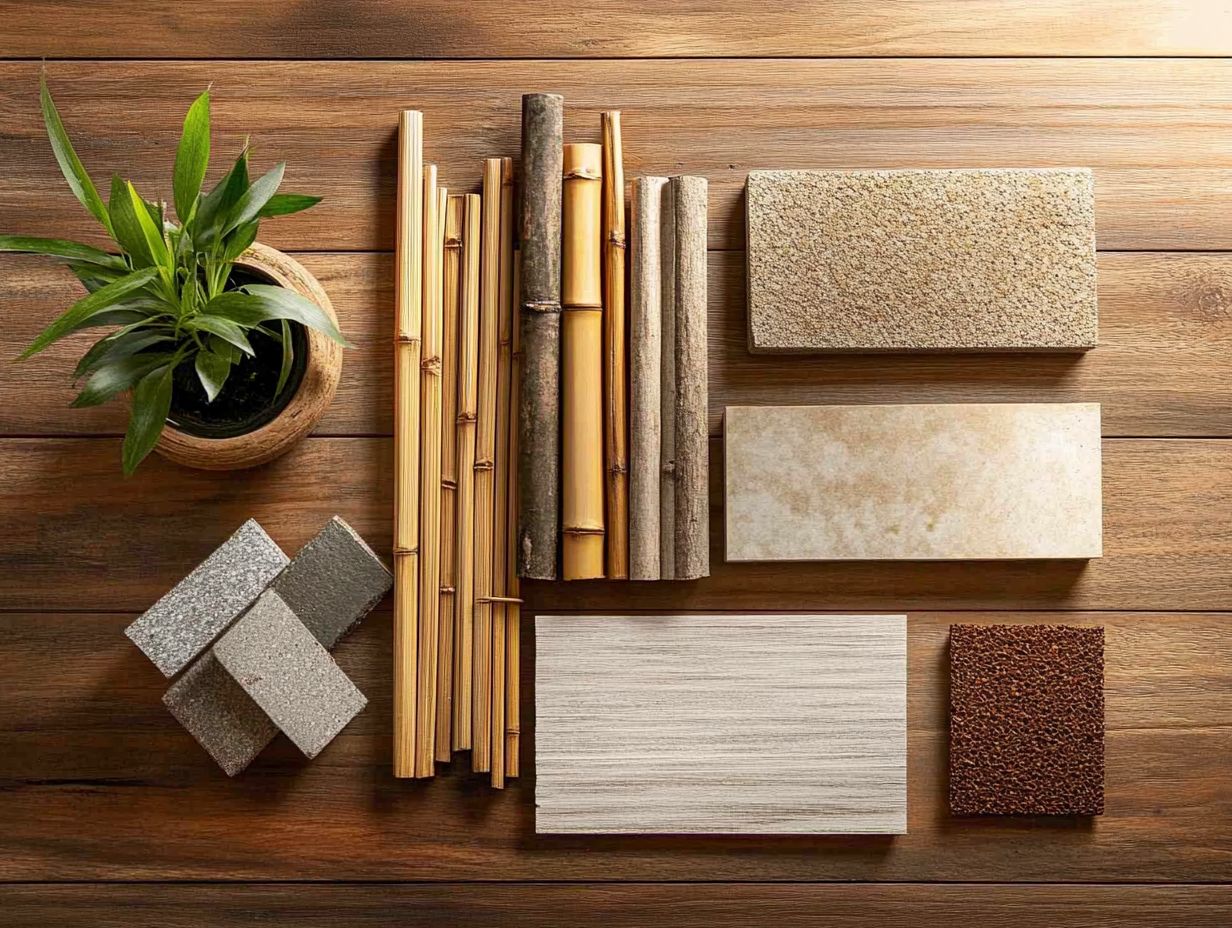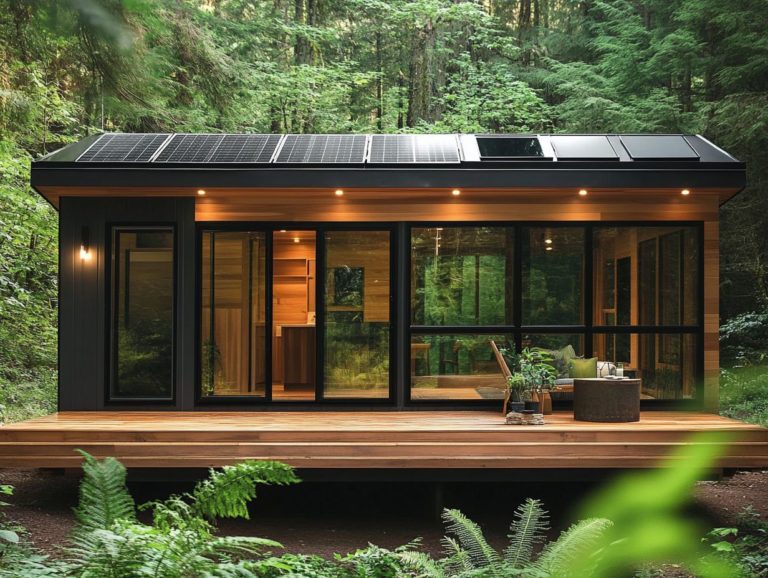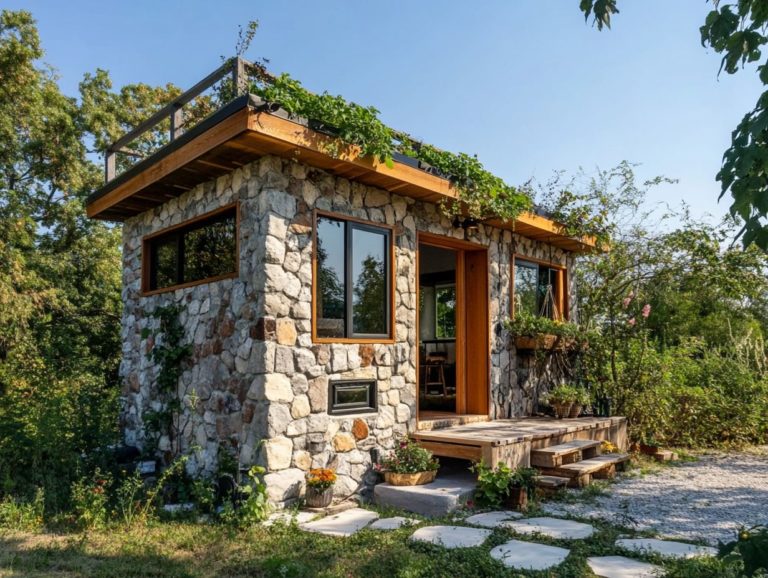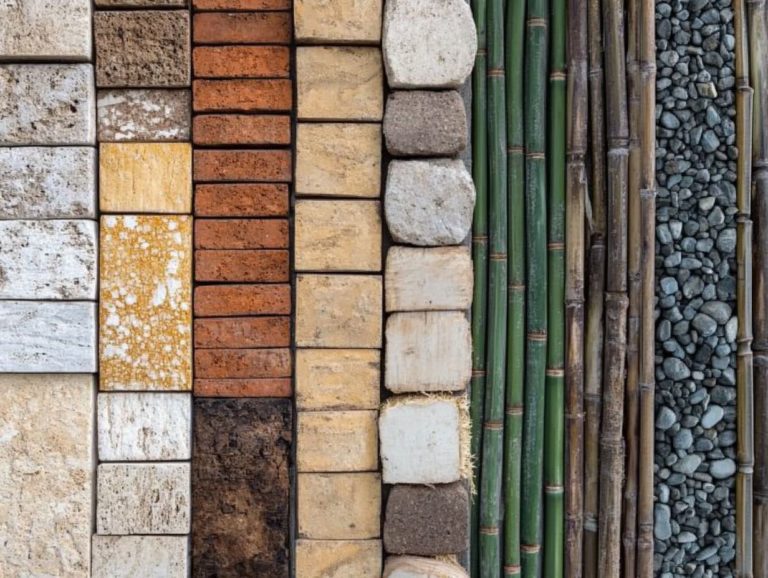5 Tips for Finding Sustainable Materials for Tiny Homes
Building a tiny home isn t merely about downsizing; it s a remarkable opportunity for you to embrace sustainability in your life!
With the right choices, you can craft a space that s not only eco-friendly but also remarkably efficient. This article presents five essential tips for sourcing sustainable materials, helping you construct a tiny home that truly aligns with your values.
From exploring recycled options to prioritizing energy efficiency, you ll find guidance on your journey toward a greener lifestyle. We ll also tackle common questions about sustainable materials and their myriad benefits.
Dive in and discover how to transform your tiny home into a sustainable oasis!
Contents [hide]
- Key Takeaways:
- 1. Research and Educate Yourself on Sustainable Materials
- 2. Consider Using Recycled or Reclaimed Materials
- 3. Look for Locally Sourced Materials
- 4. Explore Alternative Building Techniques
- 5. Prioritize Energy Efficiency and Renewable Energy Sources
- What Are Some Common Sustainable Materials Used in Tiny Homes?
- How Can One Determine If a Material is Truly Sustainable?
- What Are the Benefits of Using Sustainable Materials in Tiny Homes?
- What Are the Challenges of Using Sustainable Materials in Tiny Homes?
- How Can One Incorporate Sustainable Materials into the Design of a Tiny Home?
- What Are Some Resources for Finding Sustainable Materials for Tiny Homes?
- Frequently Asked Questions
- What are some common sustainable materials used in tiny homes?
- How can I determine if a material is sustainable?
- Are there any eco-friendly options for exterior materials in tiny homes?
- Is it possible to find affordable sustainable materials for tiny homes?
- What are some considerations when choosing sustainable materials for insulation in a tiny home?
- How can I ensure that the materials I choose for my tiny home are truly sustainable?
Key Takeaways:

- Do your research and educate yourself on sustainable materials to make informed decisions for your tiny home.
- Consider using recycled or reclaimed materials to reduce waste and give new life to old materials.
- Look for locally sourced materials to support your community while minimizing greenhouse gas emissions from transportation.
1. Research and Educate Yourself on Sustainable Materials
Understanding sustainable materials is crucial for anyone looking to build an eco-friendly tiny house. These materials not only lessen your impact on the environment but also enhance your commitment to sustainable living.
In today s world, where environmental issues are increasingly prominent, it’s essential for you to seek out reputable sources that provide valuable information on sustainable materials. Online platforms like EcoBuilding Pulse and the Green Building Council serve as excellent starting points, offering insights into certifications and material specifications.
When evaluating materials, consider key factors such as durability, cost, and the recycling process. These aspects can significantly impact long-term sustainability. By making informed choices about these materials, you can reduce greenhouse gas emissions, promoting a healthier planet.
Your tiny home will not only take up less physical space but also contribute to a healthier planet.
2. Consider Using Recycled or Reclaimed Materials
Utilizing recycled or reclaimed materials in your tiny home construction minimizes waste and infuses your eco-friendly abode with unique character and charm, making it truly one-of-a-kind!
This approach invites you to incorporate innovative features like shipping containers, which are both affordable and durable, or ecobricks plastic bottles filled with non-biodegradable waste that can serve as building blocks. Designers creatively leverage these materials to craft striking facades or even entire rooms while demonstrating a commitment to sustainability.
This practice saves money and helps the environment by cutting down waste and greenhouse gas emissions.
The blend of these reclaimed resources provides a rustic aesthetic that many find appealing, generating a warm and inviting atmosphere that makes your space feel like home!
3. Look for Locally Sourced Materials
Choosing locally sourced materials for your tiny home supports local economies and significantly reduces the environmental impact of transporting materials.
This approach enables you to utilize unique resources that showcase the natural beauty and craftsmanship of your area. For example, reclaimed wood from local barns adds character while minimizing the demand for new lumber production, which can be harmful to the environment.
By opting for these region-specific materials, you can create a tiny home that s not only eco-friendly but also steeped in local culture and history, making your living space truly one-of-a-kind!
4. Explore Alternative Building Techniques

Innovative alternative building techniques, like modular construction and passive solar design, are transforming how you approach eco-friendly tiny house construction. These methods blend efficiency with sustainability.
They minimize waste and enhance energy conservation. By employing smart technologies, you can optimize energy use through systems adjusting lighting and heating based on occupancy and weather conditions. This makes your home smarter and more efficient.
Innovative insulation methods, such as recycled materials and better insulation techniques, also reduce energy consumption while enhancing indoor comfort. Combining these approaches makes your tiny home a testament to sustainable living, lowering ecological footprints while providing modern comforts.
5. Prioritize Energy Efficiency and Renewable Energy Sources
Prioritizing energy efficiency and renewable energy sources, like solar solutions, is essential to reduce the carbon footprint of your tiny home. Embracing sustainable living is crucial in today s world.
Integrating high-efficiency appliances can significantly lower energy consumption by minimizing waste while delivering top-notch performance. Opting for LED lighting offers another advantage; it consumes less energy than traditional bulbs and lasts longer, so you won t need frequent replacements.
Employing innovative insulation techniques, such as utilizing reclaimed materials or advanced foam products, can be a game changer. It helps you maintain comfortable indoor temperatures and reduces dependence on heating or cooling systems.
By incorporating renewable energy sources like wind turbines or geothermal systems, along with solar panels, you can turn your tiny home into a self-sustaining oasis. Live comfortably while being mindful of your ecological footprint!
What Are Some Common Sustainable Materials Used in Tiny Homes?
Common sustainable materials in tiny homes include reclaimed wood, bamboo flooring, and recycled materials. These options resonate with eco-friendly building practices, including greywater recycling (reusing water from sinks or showers) and composting toilets.
These materials elevate the aesthetic appeal and structural integrity of your space while significantly reducing waste. For example, reclaimed wood allows you to repurpose timber from old structures, effectively preventing deforestation and adding unique character to your design. Bamboo is celebrated for its rapid growth and renewability, providing a strong yet lightweight flooring option ideal for compact living.
Incorporating recycled materials, like repurposed metal or glass, minimizes landfill contributions and cuts down on energy costs linked to new production. By choosing these sustainable materials, you actively contribute to a lower carbon footprint and support a healthier planet.
How Can One Determine If a Material is Truly Sustainable?
Determining whether a material is genuinely sustainable requires assessing various factors, including its lifecycle, environmental impact, and alignment with eco-friendly practices. These elements are crucial for responsible tiny home construction.
To evaluate material sustainability effectively, apply several criteria. Certifications like FSC (Forest Stewardship Council) and Cradle to Cradle provide valuable insights into sourcing practices for wood and other materials.
Habitat4Humans emphasizes the importance of selecting locally sourced materials. This choice not only reduces transportation emissions but also supports local economies. Conducting thorough environmental impact assessments is essential; this helps identify potential negative effects on ecosystems.
By analyzing sourcing practices and materials, both Habitat4Humans and other pioneers in sustainable building cultivate a deeper awareness of the long-term implications of your material choices. Explore the top 10 sustainable building techniques for tiny houses and choose sustainable materials now to make a lasting impact!
What Are the Benefits of Using Sustainable Materials in Tiny Homes?

Sustainable materials in tiny homes offer benefits that extend beyond helping the planet. They also improve energy efficiency, reduce utility costs, and enhance indoor air quality.
You can further enhance these benefits with high-efficiency appliances and smart technologies. By choosing materials such as reclaimed wood, bamboo, and recycled metal, you lessen your carbon footprint while elevating the role of sustainability in tiny house construction of your living space.
Take bamboo, for example. It grows quickly, making it a renewable resource that offers excellent insulation, helping you maintain comfortable temperatures throughout the year. For more insights on sourcing such materials, check out how to source sustainable materials for your tiny home. This can lead to substantial savings on your heating and cooling bills.
Using low-VOC paints and finishes dramatically enhances your indoor air quality, minimizing the health risks linked to common household pollutants. Incorporating energy-efficient appliances and fixtures multiplies these benefits, creating a living environment that nurtures both your well-being and environmental responsibility.
What Are the Challenges of Using Sustainable Materials in Tiny Homes?
While using sustainable materials in tiny homes offers a wealth of benefits, it also introduces certain challenges, such as higher costs, availability issues, and potential design constraints.
These obstacles might discourage you from exploring eco-friendly options. However, with proactive strategies, you can carve out a more sustainable path.
Building strong relationships with local suppliers allows you to access eco-conscious materials at competitive prices, easing the financial strain. Investigating innovative alternatives like reclaimed wood or recycled metal can lead you to durable solutions that don’t compromise on style, especially when designing a tiny house for sustainability.
Emphasizing creative design flexibility allows even the coziest spaces to embrace sustainable practices without sacrificing functionality or aesthetic appeal. To enhance your efforts, learn how to choose eco-friendly flooring for tiny homes and make it a priority to educate yourself and build partnerships in the industry. This empowers you to tackle challenges head-on!
How Can One Incorporate Sustainable Materials into the Design of a Tiny Home?
Incorporating sustainable materials into your tiny home design can be a seamless process with thoughtful planning. Every component, from energy-efficient appliances to multi-functional furniture, should serve both aesthetic and practical purposes.
When considering your layout and design, prioritize open spaces that enhance natural light and airflow. This creates a more inviting atmosphere and reduces your dependence on artificial lighting.
Using reclaimed wood, bamboo, or sustainable building materials for tiny homes adds unique character to your home while underscoring your commitment to sustainability. Bringing greenery into your space through vertical gardens or indoor plants significantly improves air quality and creates a refreshing environment.
Opt for finishes that are low in volatile organic compounds (VOCs) to promote the well-being of everyone living there. By blending innovative solutions with functional design, your tiny home can effortlessly meet the demands of modern living while remaining environmentally conscious. For more insights on building your space, explore the best materials for tiny house construction.
What Are Some Resources for Finding Sustainable Materials for Tiny Homes?
Finding sustainable materials for your tiny home can be quite straightforward when you tap into a variety of resources. Consider local suppliers, environmental events like TinyFest, and online platforms dedicated to green building, including options from Tiny Heirloom or Habitat4Humans.
These channels grant you access to top-notch, environmentally friendly materials. They also connect you with knowledgeable professionals who can guide you through the selection process. Websites such as Green Building Advisor or EcoBuilding Bargains serve as valuable treasure troves of information on sourcing reclaimed wood: a sustainable choice for tiny houses, recycled insulation, and other sustainable options.
Local organizations, like Habitat for Humanity ReStores, often host workshops and events that highlight the importance of using sustainable resources in construction. By using these resources, you can make informed decisions that resonate with your eco-friendly lifestyle, ensuring your tiny home incorporates sustainable design practices that are both stylish and sustainable.
Frequently Asked Questions

What are some common sustainable materials used in tiny homes?
Some common sustainable materials used in tiny homes include reclaimed wood, bamboo, recycled metal, cork, and natural insulation materials such as sheep’s wool or cotton.
How can I determine if a material is sustainable?
Look for materials made from renewable resources, have a low carbon footprint, and are non-toxic. Research the company and their production processes to ensure they align with sustainable practices.
Are there any eco-friendly options for exterior materials in tiny homes?
Yes, there are many eco-friendly options for exterior materials such as reclaimed wood siding, solar panels, and living roofs. These materials reduce environmental impact and can also save on energy costs over time.
Is it possible to find affordable sustainable materials for tiny homes?
Yes, it is possible to find affordable sustainable materials for tiny homes. Look for local suppliers or search for recycled or repurposed materials. You can also consider DIY projects using salvaged materials.
What are some considerations when choosing sustainable materials for insulation in a tiny home?
When choosing insulation, consider materials that are non-toxic and durable enough to withstand the movement and compact spaces in a tiny home. Look for options with a high R-value, which measures the insulation s ability to resist heat flow. Researching eco-friendly insulation options such as sheep’s wool or recycled denim can also be beneficial.
How can I ensure that the materials I choose for my tiny home are truly sustainable?
One way to ensure the materials you choose are sustainable is to look for certifications or third-party verifications, such as the Forest Stewardship Council (FSC) or the Environmental Protection Agency’s (EPA) Energy Star label. Consulting with a sustainability expert or seeking out reputable sources for information on sustainable materials can also help.






